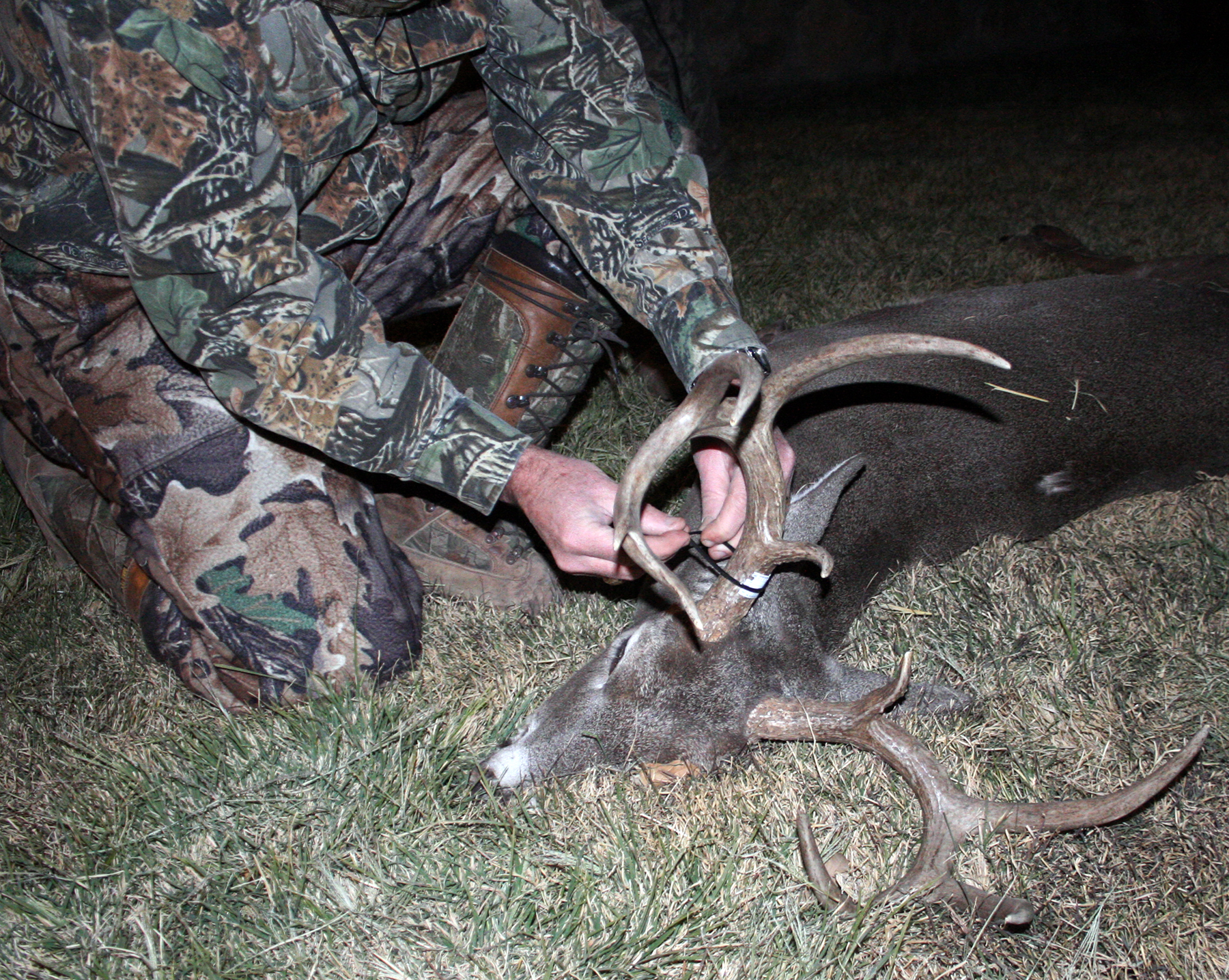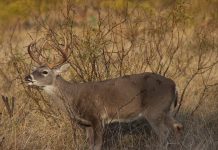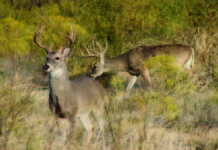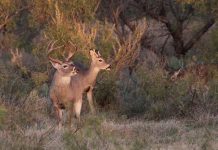The Texas deer hunting forecast typically involves little in the way of new developments, but in a state with the largest whitetail population in the country, that’s nothing to fret about.
However, the 2016-17 hunting frameworks will feature a number of big changes all aimed at improving access and opportunity, largely in helping to fill tags. The Texas Parks & Wildlife Commission adopted a variety of deer hunting alterations this year, including expanding seasons into more than a dozen counties across the western Panhandle, while creating additional deer hunting prospects in East Texas.
Notable changes to 2016-17 deer seasons include:
- Implementing a general and special archery-only season for white-tailed deer in Andrews, Bailey, Castro, Cochran, Gaines, Hale, Hockley, Lamb, Lubbock, Lynn, Parmer, Terry and Yoakum counties, with a bag limit of three deer (no more than one buck and no more than two antlerless), which is identical to adjoining/nearby counties that currently have a season.
- Implementing a general and special archery-only season for white-tailed deer in Winkler County, with a bag limit of three deer (no more than one buck and no more than two antlerless, with the take of antlerless deer restricted to the archery-only season or properties issued MLDP antlerless tags).
- Allowing the take of antlerless deer without a permit on certain U.S. Forest Service Lands during youth-only seasons;
- Establishing four doe day (time periods in when antlerless deer may be taken without a permit in parts of the state where antlerless harvest regulations are conservative) in Bell (east of Interstate 35), Burleson, Ellis, Falls, Freestone, Kaufman, Limestone, Milam, Navarro and Williamson (east of I-35) counties;
- Increasing the number of doe days to 16 in Anderson, Brazos, Camp, Gregg, Grimes, Henderson, Lamar, Leon, Madison, Morris, Red River, Robertson and Upshur counties;
- Implementing a muzzleloader-only late season in Anderson, Bell (East of I-35), Brazos, Burleson, Comal (East of I-35), Delta, Ellis, Fannin, Falls, Franklin, Freestone, Grimes, Hays (East of I-35), Henderson, Hopkins, Hunt, Kaufman, Lamar, Leon, Limestone, Madison, Milam, Navarro, Rains, Red River, Robertson, Smith, Titus, Travis (East of I-35), Van Zandt, Williamson (East of -35), and Wood counties.
- Defining “unbranched antlered deer” to clarify what constitutes a legal buck across seasons and to alleviate confusion among hunters, and replace the “Special Late Antlerless and Spike-buck Season” with a “Special Late Season” to accommodate the inclusion of “unbranched antlered deer” in the bag limit.
Texas Deer Hunting Outlook
Alan Cain, the whitetail program leader for the Texas Parks & Wildlife Department, said deer production from last season should bode well, including having a good fawn crop across much of the state and a good carryover of young bucks and does into this fall.
“Deer population trends have indicated an increasing deer population in the Pineywoods, Cross Timbers, Post Oak Savannah and Rolling Plains regions,” he said. “Populations continue to remain stable in South Texas and Edwards Plateau. Statewide population trends also remain stable and hunters should expect good numbers of deer year in and year out. I would predict the statewide deer population to be above the long-term average (roughly 3.5 million). Most regions of the state received some spring rains to green up the brush and produce a few weeds that will provide adequate forage to support deer populations and help out with antler growth and fawn rearing this summer. Some deer hotbeds in the Hill Country and South Texas are still relatively dry and hunters might expect lower fawn crops in those areas, but adult deer numbers should remain stable as a whole.”
If there’s one place on the map that always seems to produce lots of deer, it’s the Edwards Plateau region that encompasses Central Texas and extends into portions of what many hunters consider East, West and South Texas. This region has boasted the highest deer densities and hunter numbers for the past three decades. There are a variety of habitats included in this general region that includes some of the Cross Timbers area, but one thing is certain: Without good moisture levels, all of the desired vegetation that deer use for forage and cover likely will have a large impact on things this season.
“The Cross Timbers has been blessed with two wet springs in a row and it is raining in Brownwood right now (late May). “Abundant rainfall has translated into excellent habitat conditions across the area,” said Kevin Mote, Cross Timbers Wildlife District Leader for TPWD. “Even though 2011 and its historic drought would have been the birth-year for 2016’s 5½-year-old bucks, good habitat conditions and a mild winter resulted in above-average body size and antler development of younger deer last year. While we may be short on age (5-year-old bucks) this year, we expect to see good numbers of trophy animals along with a plethora of younger deer available for harvest.”
Despite the competition for hunting in the area, Cain also backed up the best overall place to pursue deer in Texas, and by default, the entire country based on population numbers.
“If you want to increase your odds of harvesting a deer, I’d be looking to hunt the Hill Country,” Cain said. “I would encourage hunters to continue to fill their tags and reduce deer populations especially in drier areas of the state including the Hill Country where deer numbers are likely beyond what the habitat should be supporting. I also encourage hunters to harvest does each year. This not only keeps the population levels in check but helps to maintain a reasonable sex ratio.”
The population estimates favor certain regions of the state, and for obvious reasons, those are the hunting hot spots. The Hill Country alone supports a whitetail population of more than 2 million animals, Cain noted, while the Cross Timbers region of Central Texas harbors more than 600,000 deer in good years. Other areas of the state to certainly consider are the Post Oak region that has roughly 400,000 whitetails, while the Pineywoods annually has more than a quarter-million.
The Rolling Plains is one area to watch closely for the next few seasons, especially with added hunting opportunities in a host of new counties. The numbers may not be high, but the quality certainly could be above average, Cain noted. Another place to consider is the eastern Trans-Pecos region of far West Texas, which is typically mule deer country as a whole, but still support good numbers of whitetails for hunters seeking to get away from the crowds.
Another facet to consider in any deer forecast is the range condition factor and just how well the landscape sets up for still hunting, which relies heavily on use of a feeder.
Chronic wasting disease in Texas
When looking at the deer forecast, another new development that has become a hot-button issue is chronic wasting disease, though it should be strongly noted that the disease is not prevalent in Texas. Two new cases of chronic wasting disease in Texas captive deer, including the first confirmed from a live test tonsillar biopsy sample, were validated earlier this year, according to TPWD. A free-ranging mule deer buck shot in Hartley County last season also tested positive for the disease. The newest confirmations of captive deer bring to 10 the number of whitetails in or originating from deer breeding facilities confirmed positive for CWD in the state since June 2015, according to TPWD.
CWD was discovered in captive Colorado animals 35 years ago. However, during the past decade the disease has been detected in free-ranging deer and elk in several surrounding states and Canada. In 2002 alone, a year after Texas closed its borders to importation of deer due to disease risks, CWD was reported in free-ranging deer in South Dakota, Wisconsin, New Mexico, Illinois and Utah.
“TPWD will continue to monitor for CWD in our wild deer populations this hunting season, so hunters are once again encouraged to help out by allowing our biologists stationed throughout the state, to collect tissue samples from hunter harvested deer,” Mote said.
CWD, which has no known immunity or treatment, occurs via natural transmission in deer, elk and moose. However, research indicates that infection of livestock through natural pathways is unlikely. It should be noted that the disease has not shown the ability to jump the species barrier to humans, according to researchers. CWD has been shown to affect the brain, spinal cord and other lymph areas of infected animals, but proper field dressing typically removes any of these sites and hunters are advised to also bone out their meat. If you take animals to be processed commercially, ask that the meat be handled separately from that of others, too. If you suspect an animal you harvest has some type of disease, wildlife officials urge you to keep the carcass refrigerated or on ice and contact biologists, and certainly don’t attempt to eat any of the meat.
TPWD and Texas Animal Health Commission have developed a cooperative CWD management plan to guide the agencies in addressing risks, developing management strategies, and protecting big game resources.
Texas public hunting options
The state offers a variety of inexpensive opportunities in state parks, wildlife management areas and even private ranches each year, with thousands of permits issued annually. There also are numerous drawings for youth hunts, which not only can be a great way to introduce children to the pastime, but also to add to your potential meat haul. There are a number of hunts that typically have high numbers of applicants each year, but for as little as $3 you too can put your name in the hat for drawings for what can turn out to be great hunts.
And should you be lucky of enough to gain entry to these areas, the old saying of venison being the most expensive meat per pound certainly doesn’t hold true considering the frugal nature of the program.
One way for some hunters who may not have access to leases or family tracts of land is to buy a public hunting permit, which costs $48, and take advantage of hundreds of thousands of acres that are available. That permit can be used to gain access to a variety of resources on almost a million acres.
“For those of you that might not have time to do the research to find a deer hunting lease consider putting in for one of the drawn deer hunts conducted on TPWD Wildlife Management Areas and State Parks. Each year some good bucks are bagged on our WMAs and lots of hunters go home with an ice chest full of venison from an antlerless and spike hunts,” Cain said.
This season has shaped up to be superb regardless of what whitetail country you’re hunting. There are opportunities galore when it comes to filling your tags. Texas long has had the greatest whitetail hunting in the country, not just for the folks who can afford to spend the big bucks in their attempts to harvest the bucks and does, but also for the average hunter who still enjoys hunting as much as possible but may not necessarily get to head afield as much as they’d like.
This should be a perfect year to get back to the basics of deer hunting – mainly the opportunity to spend time outdoors while providing for your family should you enjoy success, Cain said.
“Who knows, this may be the year you take your biggest buck, fill every tag on your license, or more importantly, enjoy the time spent in the field hunting whitetails with your family and friends. It’s all the more special if you can spend that hunting with kids. So don’t get caught sitting on the couch this fall watching hunting shows; the deer are out there waiting for you,” he said.






















